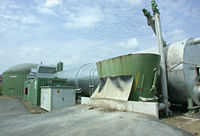
Photo from wikipedia
Rangelands of Tunisia show a great indigenous species diversity with considerable potential as forage for livestock. However, information on their fodder yield and quality is scanty and restricted to few… Click to show full abstract
Rangelands of Tunisia show a great indigenous species diversity with considerable potential as forage for livestock. However, information on their fodder yield and quality is scanty and restricted to few species. The objective of the study was to evaluate the nutritive values of selected key perennial species based on their biomass yield, chemical composition, in vitro organic matter digestibility (IVOMD), and mineral composition. The species evaluated included four grass species (Stipa lagascae Roem. and Schult., Stipa tenacissima L., Stipagrostis plumosa (L.) Munro ex T. Anderson, and Stipagrostis pungens (Desf.) de Winter.) and eight shrub species (Anthyllis henoniana Coss. ex Batt., Argyrolobium uniflorum (Deene.) Jaub. and Spach., Echiochilon fruticosum Desf., Gymnocarpos decander Forssk., Helianthemum kahiricum Delile., Helianthemum lippii (L.) Dum. Cours., Plantago albicans L. and Rhanterium suaveolens Desf.). Results showed that shrub species contained higher concentrations of the crude protein (CP), acid detergent lignin (ADL), but lower neutral detergent fiber (aNDFom) and acid detergent fiber (ADFom) concentrations than grasses. The greatest concentration of CP was 135 g/kg DM for R. suaveolens. The greatest aNDFom concentration was found within the grasses with maximum of 744.5 g/kg DM in S. plumosa. The shrub species E. fruticosum, A. uniflorum, P. albicans, G. decander, R. suaveolens, and A. henoniana had the highest IVOMD with over 500 g/kg DM and have the potential to supply energy to livestock. Overall, the moderate to high protein, low fiber, and high in vitro digestibility measured for shrubs, suggest they have high nutritional values and can be used to enhance local livestock production.
Journal Title: Plants
Year Published: 2021
Link to full text (if available)
Share on Social Media: Sign Up to like & get
recommendations!